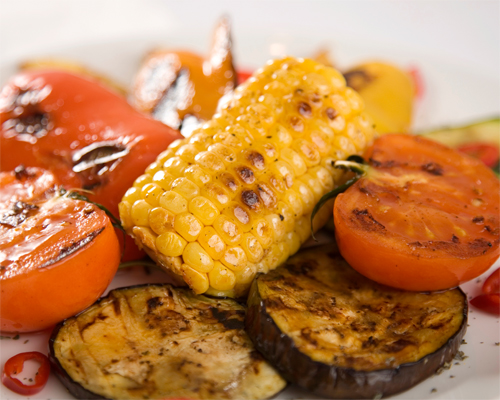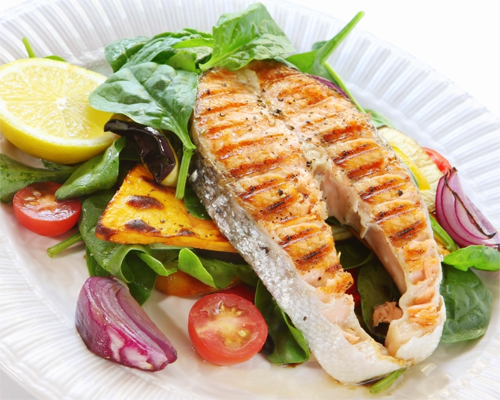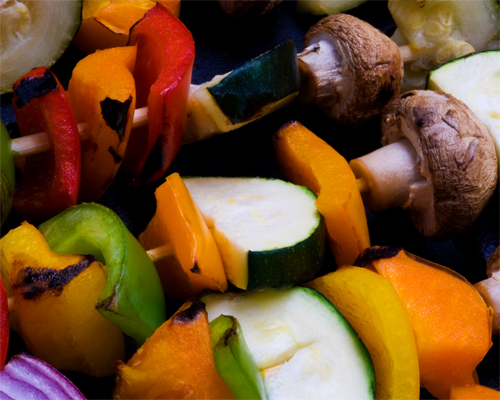
Fact Sheet FS1089
Use of the backyard grill or barbecue to prepare meals on hot summer evenings and for holiday picnics is as American as apple pie. Grilling not only helps to keep the heat out of the kitchen, but it is also a fun and tasty way to serve up favorites such as grilled fish and chicken. Grilling is also an opportunity for bacteria to form that can lead to food borne illness if food is not cooked properly. According to the Centers for Disease Control and Prevention (CDC), approximately 48 million people get sick as a result of a food-borne illness each year. In addition to this, ongoing evidence suggests that cooking certain foods at high temperatures may result in other health risks. Following food safety guidelines carefully before, during, and after grilling to prevent food-borne illness and limit health risks is an important part of grilling with care.
Before Grilling
Keep all perishable foods that are headed for the grill cold until you are ready to prepare them. This is an important step in avoiding food-borne illness. Here are some reminders:
- Transport cold food home from the store in a cooler with ice packs
- Refrigerate within 2 hrs when the outdoor temperature is below 90°F
- Refrigerate within 1 hr when the outdoor temperature is above 90°F
- Keep cold foods at 40°F or below until time to place on the grill
- Defrost meat, fish, or poultry in the refrigerator on a plate to catch any drippings
If you like to marinate your food before grilling to enrich its flavor or tenderize it, remember to:
- Always marinate food in the refigerator
- Discard or boil any unused marinade that has been used on a perishable item such as meat, fish, or poultry
- Boil the marinade or a portion of unused marinade to be used later on the cooked food
Choosing what to put on the grill has taken on new importance according to top cancer prevention experts from the World Cancer Research Fund (WCRF) and the American Institute for Cancer Research (AICR). A recent report from these organizations suggests that diets high in red meat—including beef, pork, lamb, and processed meats such as hot dogs—may be linked to cancer of the colon. As a result of this report, recommendations include:
- Avoiding processed meats
- Limiting red meat to 18 ounces (cooked) each week
Although these recommendations include some old grilling favorites, choosing more poultry, fish, and vegetables for the grill may lead to some new favorites. For example, try Vegetable Kebabs (below) served over brown rice for a delicious summer treat.
| Food | Temperature |
|---|---|
| Fish | 145°F |
| Steaks & Roasts | 145°F |
| Ground Beef | 160°F |
| Pork | 145°F |
| Poultry | 165°F |
During Grilling
To continue grilling with care, be sure to cook meat, fish, and poultry to a safe minimum internal temperature to destroy harmful bacteria. This cannot be done by looking at the food. Due to the high heat of the grill, foods often cook faster on the outside and may look done before they truly are. To be sure it is done on the inside, use a food thermometer.
The high heat of the grill is also responsible for flare-ups that can cause the outside of food to become charred. Some studies suggest that there may be a cancer risk when protein foods such as meats, poultry, or fish are cooked at high temperatures. Researchers know that certain cancer-causing substances are formed during grilling and other high-heat cooking methods. Some of these substances are produced in "muscle meats" such as red meat, poultry, game, and fish during the high-heat cooking methods. Others are formed when the fat drips onto the hot stones or coals of the grill, accumulating onto the food when smoke and flare-ups occur. As a result, experts recommend that we:
- Eat moderate amounts of grilled protein foods
- Avoid charring of grilled protein foods
Partially cooking food in the mircrowave, in the oven, or on the stove will help to reduce grilling time and decrease the opportunity for charring. This method can be used safely if the food is taken from the precooking source and placed directly on the grill to complete cooking. All perishable foods should be cooked thoroughly without interruption to avoid development of harmful bacteria. Additional suggestions to keep grilling safe are found in the box Tips for Grilling with Care.
After Grilling
Once food has reached a safe minimum internal temperature and is removed from the grill:
- Place on a clean platter, being sure to not place it on the plate that held the raw meat, poultry, or fish
- Keep food hot at 140°F or above until it is served
- Refrigerate cooked items within 2 hours in mild weather
- Refrigerate cooked items within 1 hour when the outside termperature is at 90°F or above
Tips for Grilling with Care
- Grill more vegetables and fruits
- Choose poultry and fish over beef, pork, and lamb
- Marinate protein foods before grilling, and turn them frequently to reduce the production of cancer-causing substances
- Reduce flare-ups by spreading aluminum foil on the grill, making small holes in the foil to allow fat to drain
- Pre-cook protein foods before grilling to shorten the grilling time
- Choose lean cuts to decrease fat drippings on the coals
- Cook in the center of the grill and move coals to the side to keep fat from dripping on them
- Grill smaller portions to decrease the exposure time to high heat
- Remove and discard any charred portions on protein foods
- "Barbecue" in the oven anytime of the year by spreading your favorite sauce on chicken breasts or lean chops and bake until done
Sources
- World Cancer Research Fund/American Institute for Cancer Research. Food, Nutrition, Physical Activity, and the Prevention of Cancer: A Global Perspective. Washington, DC: AICR, 2007
- www.aicr.org
- www.fsis.usda.gov
- www.cdc.gov
Photo credits: www.istockphoto.com.
Recipes
Try this AICR Health–e-Recipe that shows how grilling vegetables is a great way to grill safely and increase vegetable intake at the same time:
Vegetable Kebabs
Ingredients:
- 1 small eggplant, cut in half lengthwise, then into thick chunks (peeled if desired)
- 1 small red onion, sliced and cut into 8 wedges
- 1 zucchini, cut in half lengthwise, then into thick chunks
- 1 yellow summer squash, cut in half lengthwise, then into thick chunks
- 1 red bell pepper, seeded and cut into eighths
- 2 Tbsp. balsamic or red wine vinegar
- ¼ cup canola oil
- ¼ cup plus 1 Tbsp. minced fresh basil (or 1 Tbsp. plus 1 tsp. dried), divided
- ¼ cup non-fat plain yogurt
- 2 Tbsp. non-fat mayonnaise
- 1 tsp. fresh lemon juice
Directions:
- Thread 8 skewers, 2 skewers of each vegetable, keeping each vegetable on separate skewers. Place the vegetables in a shallow pan large enough to hold the skewers.
- Make the marinade by whisking together in a small bowl the vinegar, oil, and ¼ cup of fresh basil (or 1 tablespoon dried). Pour the marinade over the vegetables. Let them stand for 10 minutes, occasionally turning the skewers so the marinade coats all sides.
- Meanwhile, make the dressing: Place the yogurt, mayonnaise, the remaining 1 Tbsp. of fresh basil (or 1 teaspoon dried) and lemon juice in a blender and mix at low speed until it is smooth.
- Grill the vegetables starting with the eggplant. About five minutes later, add the onions, and then about five minutes after that, add the rest of the vegetables (adjusting height of rack to avoid charring). Grill to your liking and serve with the dressing drizzled over top.
Makes 8 servings of ½ cup each.
Nutritional Information per ½ cup:
- Calories: 97
- Total Fat: 7 g
- Saturated Fat: < 1g
- Sodium: 39 mg
- Carbohydrates: 8 g
- Dietary Fiber: 1 g
- Protein: 2 g
May 2017
Copyright © 2025 Rutgers, The State University of New Jersey. All rights reserved.
For more information: njaes.rutgers.edu.
Cooperating Agencies: Rutgers, The State University of New Jersey, U.S. Department of Agriculture, and Boards of County Commissioners. Rutgers Cooperative Extension, a unit of the Rutgers New Jersey Agricultural Experiment Station, is an equal opportunity program provider and employer.



